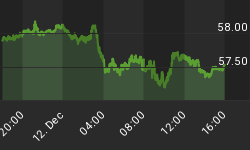In previous commentaries we've explained why the US Government could be expected to do everything in its power to prevent the current downward trend in the money supply growth rate from continuing. We've also mentioned that going to war has, in the past, been a strategy used by governments to promote money-supply growth (wars provide an excuse to quickly borrow a lot of money into existence). There might not actually be a direct relationship between war and sustained declines in the money-supply growth rate to levels considered by policy-makers to be 'dangerously low'. It seems, however, that opportunities to go to war are seized upon when certain conditions are in place, and one such condition is a sharp decline in the money supply growth rate.
On a related matter, studies of long-term cycles by the famous Russian economist Kondratieff and others have shown that both the frequency and amplitude of military conflicts tend to increase after commodity prices have hit major (secular) lows and turned higher.
Further to the above, in his interesting and controversial book "War Cycles Peace Cycles" Richard Kelly Hoskins correlates secular commodity price trends, war, peace, and the practice of borrowing money into existence. He produced the following chart representing the secular trends in commodity prices over the past 340 years and explained that most of the important conflicts occurred during the 'up phases' on the chart. The secular up-trends for commodity prices were hence termed "war cycles" and the downtrends termed "peace cycles". Hoskins' book was written in 1985, so there is no date shown for the bottom of the "peace cycle" that began in 1980. However, if the 1999 low for commodity prices turns out to be THE major bottom then we are presently in the fourth year of a "war cycle" that is likely to last at least 20 years.

According to Hoskins, an important driver of the cyclical behaviour illustrated above is the practice of charging interest on money because this practice leads to the total of all obligations to pay money being greater than the total supply of money. Such a scheme is inherently unstable, meaning that a system-threatening crisis is inevitable at some point. Furthermore, under our current monetary system the problem is magnified because almost ALL money comes into existence as the result of a loan. This means that new money must be created at a fast enough pace to enable existing debts to be paid off, but then each new dollar borrowed into existence just adds to the problem. At some point the pool comprising all existing and potential borrowers becomes unwilling, or unable, to increase its debt burden. When this happens the money supply stops growing or even begins to contract, making it impossible for many borrowers to get hold of enough money to pay their debts. The result is that these borrowers lose a lot of what they worked hard to accumulate and the social mood, in turn, becomes more conducive to war.
During previous long-term cycles, the production of commodities represented a substantial portion of the economy in countries such as the US. This meant that money-supply growth rates and commodity prices were well-correlated, that is, periods of rising money-supply growth generally coincided with periods of rising commodity prices and periods of falling money-supply growth generally coincided with periods of falling commodity prices. As such, major peaks and troughs in money-supply growth always roughly coincided with major peaks and troughs in commodity prices. And after prices and money-supply growth hit rock bottom a new long-term upward trend, propelled in part by the borrowing of money into existence to finance war, would begin. Note that "upward trend", in this context, refers to the commodity-price level and the money supply growth rate, not the real economic growth rate.
During the current cycle we either have something different on our hands, perhaps due to the lesser importance of commodity production to the economies of most 'first world' countries, or the down cycle (the "peace cycle") is not yet complete. We say this because it is normal for commodities, stocks and real estate to bottom at around the same time during the transition from the "peace cycle" to the "war cycle" (the stock market tends to do well throughout much of the "peace cycle", but eventually falls prey to a combination of its own over-valuation and the falling money-supply growth trend). Clearly, neither stock prices nor real estate prices were remotely close to important lows when commodity prices were bottoming over the past few years.
Then again, perhaps the real difference this time around is that the strategies that have previously only been attempted in response to a system-threatening crisis have been brought into play prior to such a crisis (in an effort to prevent, or postpone, the inevitable crisis). For example, in the past the money-supply growth rate has fallen off a cliff shortly after a major stock market bubble has burst, but the US money-supply growth rate continued higher for 2 years after the bursting of the most recent stock market bubble. And although it has been trending lower over the past 16 months it is still at a 'healthy' level by historical standards. Also, we are now witnessing aggressive deficit spending combined with large tax cuts and war even though things haven't yet become that bad (as far as outward appearances are concerned, anyway). In other words, we appear to be seeing a number of pre-emptive strikes designed to dampen the cyclical oscillations caused by the use of unsound money. As always, though, these attempts by government to avoid 'paying the piper' will have unintended consequences (things will inevitably be made worse, not better).
















